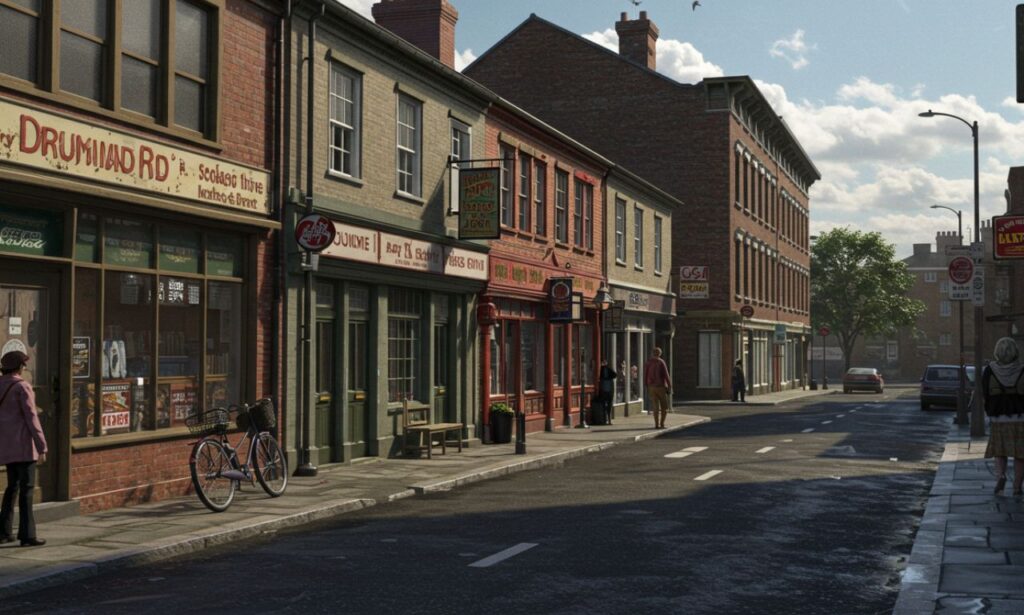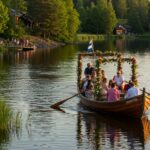The name Drummond Rd evokes mystery — a street, or many streets — across different cities, each with its own story. In this article, we dive into what “Drummond Rd” means in various locales: its history, its geography, its challenges, and what lies ahead for the road(s) that bear this name. We’ll examine examples from Canada, the U.S., and elsewhere, and reflect on the role a street name can play in shaping identity, infrastructure, and community.
Drummond Rd: Definition and Global Distribution
“Drummond Rd” (or “Drummond Road”) is not a single unique street but a name used in multiple cities and regions worldwide. Its occurrence reflects historical naming practices, local geography, and sometimes homage to individuals named Drummond.
You can find Drummond Rd in places including:
-
Toledo, Ohio, USA — residential neighborhoods.
-
Niagara Falls, Ontario, Canada — a significant road in the Niagara region.
-
Shaker Heights, Ohio, USA — as part of a well-known neighborhood’s street layout.
-
Greenacres, Washington, USA — a residential listing on S Drummond Rd.
-
Mississauga, Ontario, Canada — as a part of local road networks.
Because of this dispersion, when one refers to “Drummond Rd” the context (city or country) matters a lot. In what follows, we will look at several examples and themes that reveal what Drummond Rd represents in those settings.
Drummond Rd in Toledo, Ohio
In Toledo, Drummond Rd is a residential artery dotted with single-family homes. For instance:
-
4232 Drummond Rd, Toledo, OH is a 3-bedroom, 2-bath home built in 1955.
-
3434 Drummond Rd, Toledo, OH is another property (3 beds, 1 bath) originally built in 1939.
These properties reflect mid-20th century suburban development, a pattern common in many American cities. Drummond Rd in Toledo serves as a local collector road, connecting neighborhoods to larger arterials. Its role is modest but important: delivering residents to schools, shops, and larger thoroughfares.
In that context, Drummond Rd’s identity is residential. It is subject to typical issues: property maintenance, traffic calming, street lighting, and neighborhood safety. Local property values tend to be tied to commuting convenience, school quality, and infrastructure on roads like Drummond.
Drummond Rd in Niagara Falls, Ontario
In Canada, Drummond Rd in Niagara Falls, Ontario carries more significance than just as a residential street. One address, 4465 Drummond Rd, is part of the Niagara Falls road network
The name “Drummond” in this region may trace back to Sir Gordon Drummond, a colonial military administrator, whose name is linked to various places (e.g. Drummondville, Drummond Island).Thus, Drummond Rd in Niagara may carry a legacy commemoration.
Because Niagara Falls is a major tourism region, roads such as Drummond Rd often serve two functions: local traffic and tourist traffic. The road’s condition, signage, connectivity to scenic routes, and integration into regional traffic planning are critical. For example, during peak tourist seasons, roads like Drummond Rd may bear heavier load and need robust maintenance.
Drummond Rd in Shaker Heights, Ohio
Another instance, 2824 Drummond Rd in Shaker Heights, OH, is part of one of the most prestigious suburban neighborhoods near Cleveland.
Shaker Heights is known for planned neighborhoods, historic architecture, tree-lined streets, and restrictive zoning. In such areas, roads like Drummond Rd are not mere conduits but part of the neighborhood’s aesthetics and character. The design, paving, sidewalks, landscaping, street trees, and lighting are often held to high standards.
Thus Drummond Rd in Shaker Heights is not just a utilitarian road — it’s an amenity. Residents expect quality infrastructure, safe pedestrian crossings, and integration with the neighborhood feel.
Drummond Rd in Greenacres, Washington
In Greenacres, WA, 1107 S Drummond Rd is a newer home, 4 beds and 3 baths, sold in 2025.
Here, Drummond Rd is part of suburban development in the Pacific Northwest, with spacious lots, scenic views, and modern design. The road supports newer subdivisions, and infrastructure such as storm drainage, sidewalks, utilities, and possibly homeowners’ association standards often govern its design and maintenance.
In such contexts, Drummond Rd is tied to growth patterns: new construction pushes roads outward, and road planning must anticipate utility placement, connectivity, and long-term maintenance.
Origins & Etymology of “Drummond” in Road Names
Why “Drummond Rd”? Several factors contribute:
-
Commemoration of a Person: Many Drummond roads owe their name to prominent individuals. For example, Sir Gordon Drummond is a historical figure tied to Canadian places.
-
Legacy Landowners: In some cases, Drummond may have been a landowner whose estate was subdivided, and roads were named accordingly.
-
Migration of Name Usage: The name Drummond may be reused across regions by settlers or urban developers honoring familiar names.
Thus, while each Rd is local, the shared name may echo colonial history, prominent families, or urban planning decisions.
Common Characteristics of Drummond Rd Streets
When we compare several Drummond Rds, certain commonalities emerge:
-
Residential emphasis: Many stretches are lined with houses, often mid-century or modern.
-
Connectivity role: They tend to act as collector or secondary roads, linking local neighborhoods to major arteries.
-
Variable importance: In tourist or commuter zones, they may carry heavier traffic; in residential enclaves, they may be quieter.
-
Infrastructure demands: Pavement maintenance, sidewalk safety, drainage, signage, lighting all matter.
-
Historic or character value: In older neighborhoods, preserving the look, trees, and curb appeal is crucial.
Yet, the specifics depend heavily on city planning, zoning law, and municipal investment.
Key Challenges Facing Drummond Rd in Various Settings
Depending on locale, Drummond Rd faces different pressures:
-
Traffic congestion & wear
In tourist or commuter corridors (e.g., Niagara region), Rd may see traffic beyond its original design. Increased load accelerates pavement deterioration, causes noise, and stresses intersections. -
Infrastructure funding
In residential zones (e.g., Toledo, Shaker Heights), funding for repaving, drainage upgrades, sidewalk repairs, and street lighting is a perennial issue for local governments. -
Balancing growth and character
Suburban expansion (e.g., Greenacres) can require widening roads or increasing utility capacity — but that can conflict with preserving neighborhood tranquility. -
Safety for vulnerable users
Pedestrians, bicyclists, children—roads like Drummond must incorporate safe crossings, sidewalks, and traffic calming in residential areas. -
Coordination with regional planning
Because Rd may cross municipal boundaries or connect to major arteries, coordination among different jurisdictions is required for coherent planning. -
Addressing naming confusion
With multiple Rds across regions, for navigation, mapping, and postal services, disambiguation becomes important (city, postal code, etc.).
Modern Upgrades & Best Practices on Drummond Rd
Across different locales, municipalities adopt several strategies to future-proof roads like Drummond Rd:
-
Complete Streets design
Incorporating bike lanes, sidewalks, green buffers, street trees, and pedestrian crossings. -
Smart traffic control
Using adaptive traffic signals, roundabouts, or speed sensors to improve flow and safety. -
Permeable paving & stormwater management
To reduce runoff in heavy rain, especially in areas with tight budgets for drainage. -
Street lighting with LED and smart sensors
For energy efficiency and safety, especially in residential areas. -
Community engagement
Residents often provide input regarding traffic calming, sidewalks, and street aesthetics. -
Preservation zones
In historic neighborhoods, ensuring that upgrades respect architectural styles, tree canopy, and heritage features.
These practices ensure that Rd remains not just functional, but a valued community asset.
Case Studies: Success and Concern on Drummond Rd
Shaker Heights, Ohio — A model suburban stretch
In Shaker Heights, Rd is part of a community with strict zoning and high standards. Investments in tree plantings, consistent pavement, and sidewalk upkeep mean Rd there is not just a local road — it is part of the identity and pride of the neighborhood.
Niagara Falls, Ontario — balancing tourism and local use
Rd in the Niagara region must serve local residents while also easing movement for tourists exploring waterfalls, parks, or attractions. The road must maintain reliability even during peak demand, which may require enhanced maintenance cycles, signage, and traffic coordination.
Toledo, Ohio — incremental upgrades
In places like Toledo, where Rd is predominantly residential, upgrades are often gradual. Streets get resurfaced, curbs replaced, drains updated, and lighting improved over time. Community involvement can ensure that improvements match the expectations of existing residents.
Future Trends That Will Affect Drummond Rd
Looking ahead, several macro trends will shape the future of Rd in cities across the world:
-
Electric vehicles (EVs): As EV adoption grows, streets need charging infrastructure. Rd may need curbside chargers or neighborhood charging hubs.
-
Autonomous mobility: Future vehicles may require lane marking precision, communication nodes, and smoother, more uniform pavements.
-
Climate resilience: With heavier storms, road designs must manage flooding, runoff, and heat stress (e.g., reflective pavement or shade).
-
Green infrastructure: Integration of bioswales, tree planting, permeable surfaces, and rain gardens along Rd can support environmental goals.
-
Smart city sensors & IoT: Traffic monitoring, lighting control, pavement health sensors — Rd may become part of the urban sensor network.
-
Enhanced public transit linkages: In urban areas, Rd could be aligned or retrofitted to serve bus rapid transit, tram lines, or shuttle routes.
Municipalities that proactively adapt to these trends will keep Rd relevant and resilient for decades to come.
Community and Social Role of Drummond Rd
A road is more than asphalt and curbs. Drummond Rd, like many local roads, helps define neighborhoods:
-
Identity: Residents reference “living off Rd,” giving the street name social meaning.
-
Connection: It’s the pathway to schools, parks, shops, and neighboring streets — a thread in the urban fabric.
-
Recreation & walkability: In many suburban settings, Rd becomes a place to walk dogs, meet neighbors, or bike.
-
Property value: The condition of Rd impacts real estate appeal. Roads with smooth pavement, safe crossings, and mature landscaping tend to boost home values.
-
Local engagement: Block parties, cleanup days, or neighborhood watches often use roads like Drummond as gathering points.
Hence, preserving and improving Rd is not just infrastructure maintenance—it’s supporting social cohesion and quality of life.
How to Learn More About a Local Drummond Rd
If you want to dig deeper into a specific Rd in your city, here’s how:
-
City planning or public works documents — Many municipalities have road improvement plans, capital budgets, or certificates of road conditions that reference Rd.
-
Historical maps & archives — Look into old city maps, land subdivision plans, or historical societies to trace how Rd evolved.
-
Property records & deed registries — You may discover the original landowners or reason for naming.
-
Community forums & local discussion — Neighborhood groups often discuss traffic issues, proposed upgrades, or incidents on roads like Drummond.
-
Satellite & GIS tools — Use map layers to see street width, sidewalk coverage, tree canopy, and utility lines.
-
Municipal traffic or engineering department — They often have traffic counts, accident data, or resurfacing plans.
By combining these sources, you can build a comprehensive profile of Rd in your area — history, current state, and future trajectory.
Conclusion
Drummond Rd may at first seem like just another street name, but across different regions it plays roles that vary from quiet residential conduits to vital tourist corridors. Whether in Toledo, Niagara Falls, Shaker Heights, or Greenacres, each Rd reflects its local context — history, growth patterns, municipal priorities, and community identity.
Though the name is shared, each Rd is different: in design, in demands, and in destiny. But common themes unite them: the need for maintenance, adaptation to future trends, and connection to community. As cities evolve, Rd will too — serving as a small but telling lens into how our roads shape life.







